YE OLD TIMBER TAVERN ON COURT ST (1926)
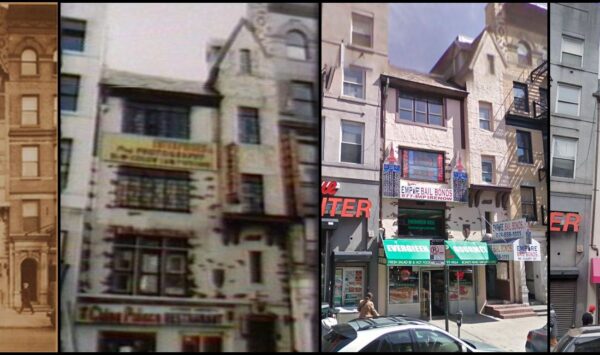
******************************************************************************************************************************** Brownstone Detectives investigates the history of our clients’ homes. The story you are about to read was composed from research conducted in the course of one of those investigations. Do you know the history of YOUR house? ******************************************************************************************************************************** Old English architecture is a rare sight in New York City. Rare, interestingly, because it once had a distinct place and time in the history of New York City’s 20th century architectural development. As tastes changed, however, its look – sometimes referred to as Tudor, Chester, Jacobean, Elizabethan, &c. – quickly fell into disfavor. Also, its reliance upon such materials as wood and stucco – those that can easily wear if not well maintained – forced owners of these structures to look for more long-term solutions to their maintenance. One of these solutions usually meant simply covering their more wearable materials with those that stood up better to weather. Although it would take nearly a century to do, such is the case with No. 93 Court Street, initially designed in the Old English style. “Brooklyn’s most distinctive office building,” started a Brooklyn Daily Eagle article in October of 1926, “may well be the description of the new home of Malkind & Weinstein, architects, which is being completed at 93 Court st., and is expected to be ready for occupancy in November.” The article went on to highlight the building’s design and beauty. “The building will carry out the style of Old English architecture in every detail in its exterior, while the […]
THE SPITE HOUSE OF MELROSE AVENUE (1899)
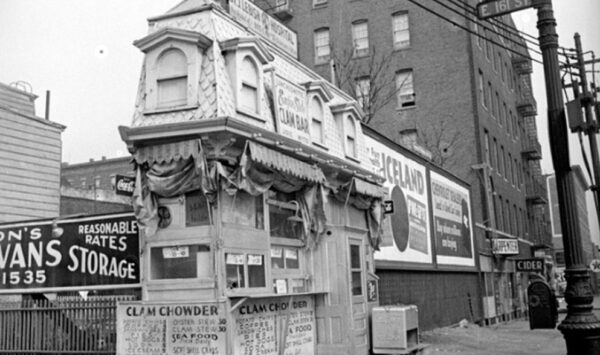
******************************************************************************************************************************** Brownstone Detectives investigates the history of our clients’ homes. The story you are about to read was composed from research conducted in the course of one of those investigations. Do you know the history of YOUR house? ******************************************************************************************************************************** Around the turn of the last century, Melrose Avenue in the Bronx was widened. The land that the city needed to perform this expansion was purchased from private owners. In some cases, however, it left some very-difficult-to-build-on lots. Such was the case with a lot on the corner of East 161st Street and Melrose Avenue. From The Strand Magazine, 1899. “This odd building stood on the corner of 161st Street and Melrose Avenue, New York City. It was a bit over 4ft. in depth, 17ft. frontage, and one and a-half storeys high, with a basement and sub-basement built under the broad sidewalk, extending to the curb. The house itself was of wood, on a steel frame, and had a slate roof. “Its owner was an eccentric tailor, who lived and carried on his trade below the street. The interior consisted of a small show-room, a store-room, and spiral iron stairway going down to the ‘lower regions.’ “The upper storey seems to have been constructed merely as a finishing touch. It was reached by an iron ladder from the store-room. The entire construction, appointments, and fittings were very ingenious, and were all the ideas of the owner. “The story of the house was that the original lot was cut away in opening […]
IS THAT A TUB IN YOUR KITCHEN? (1920)
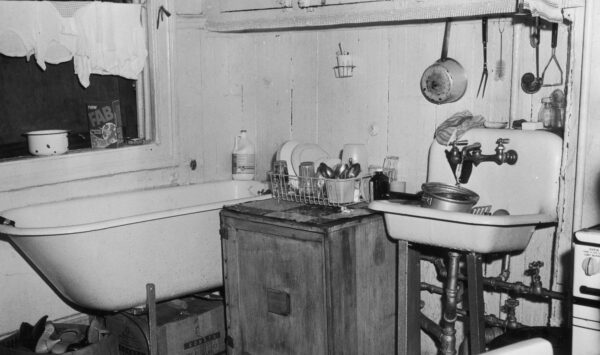
******************************************************************************************************************************** Brownstone Detectives investigates the history of our clients’ homes. The story you are about to read was composed from research conducted in the course of one of those investigations. Do you know the history of YOUR house? ******************************************************************************************************************************** The following article tells how a young lady’s visiting relation – during the New York City housing shortage of 1920 – thought it would be simple to quickly find her niece a $50 (a month!) apartment in Brooklyn – and how, upon viewing one in Brookyn Heights, she was shocked – “Shocked, I say!” – to see a bathtub in the kitchenette (or a kitchen in the bath)! – Courtesy of Brooklyn Daily Eagle, Sun., 22 August 1920 AUNT BELLA is an august soul and very imposing in her handsome second mourning. And she set her tea cup down with a force Which made me nervous for my Royal Sevres. “You needn’t tell me,” said Aunt Bella firmly. “This Housing shortage is all a myth, and is cooked up between the newspapers and the property owners to keep up the high rents. You haven’t looked, child—you admit it yourself. Right here in Brooklyn there are, I know, hundreds of apartments, kitchen, living room and bath. Here you sit and let your rent go up 25 percent, and don’t make a murmur. That will be $62.50 for this box of a place. Nonsense!” as I weakly murmured something about the intense heat. “It Would be cheaper to take a taxi today and […]
THE HIDDEN JEWELS OF No. 952 PUTNAM (1924)
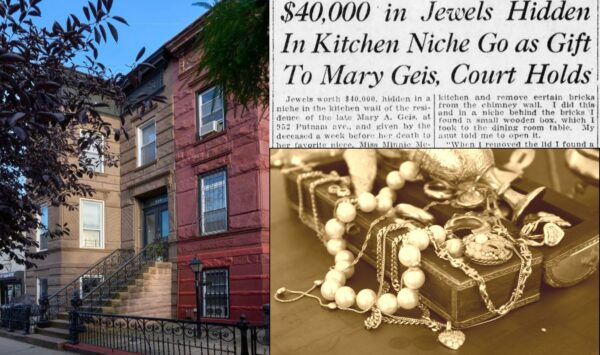
******************************************************************************************************************************** Brownstone Detectives investigates the history of our clients’ homes. The story you are about to read was composed from research conducted in the course of one of those investigations. Do you know the history of YOUR house? ******************************************************************************************************************************** In 1922, $40K in gems hidden behind some bricks in a chimney, were almost lost to the ages when their owner was about to pass away. A week before she passed, though, she directed her favorite neice to the secret location of the hidden jewels. A word to the wise when attempting to renovate your newly purchased old brownstone: “People used to hide valuables in their homes. So, look around the old joint before you invite a builder to start demolition!” (From the Brooklyn Daily Eagle, Mon., 28 January 1924.) Jewels worth $40,000, hidden in a niche in the kitchen wall of the residence of the late Mary A. Geis, at 952 Putnam avenue, and given by the deceased a week before her death to her favorite niece, Miss Minnie McDonald of 582 Woodword avenue, Queens, may be retained by the latter, despite efforts made to recover them by Joseph Geis, an executor of the will. Surrogate Wingate has handed down a decision in favor of Miss McDonald, the respondent. A week before her aunt died, according to the dramatic story told on the stand by Miss McDonald, she sent for her and told her that she was dying. “She directed me to go into the kitchen and remove certain bricks […]
THE LAST SOLAR ECLIPSE SEEN IN NYC (1925)
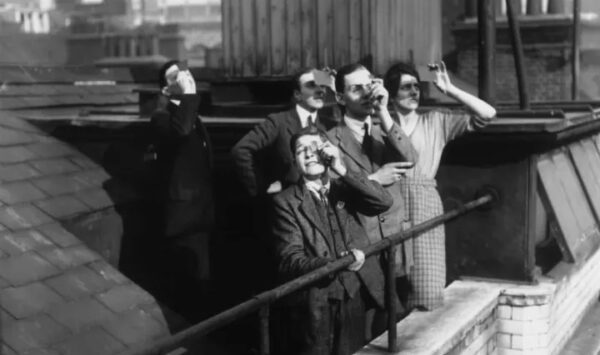
******************************************************************************************************************************** Brownstone Detectives investigates the history of our clients’ homes. The story you are about to read was composed from research conducted in the course of one of those investigations. Do you know the history of YOUR house? ******************************************************************************************************************************** “Not since the coming of the white man to America,” the Brooklyn Daily Eagle specified in January of 1925, “has a total eclipse been visible from … New York City.” The Eagle then went on to describe what to expect from the phenomenon. “A great black disc slowly blotting out the sun. The rush of a gigantic shadow across the earth abruptly turning day into night. The sudden flashing of a streaming pearly halo around the darkened sun. Outbursts of blood red light from the circumfrerence of the sun. Stars shining in the daytime. A sudden chill in the air.” The Eagle‘s words may have sounded overly dramatic, but they were true. And New Yorkers were about to find out just how true. “The most majestic and awe inspiring spectable that man can witness is the total eclipse of the sun. Millions of people will have the opportunity of observing the eclipse to occur on Saturday, Jan. 25. “No total eclipse of the sun has been visible in the northeastern part of the United States since 1806 nor will such an opportunity come again until 2024. Now THAT’s a scientific pedigree! Enjoy the Solar Eclipse! Follow @BrownstoneDetec Share ———————————————————————————————————————– The Brownstone Detectives Brownstone Detectives is an historic property research agency. Our […]
THE FARMS LINES OF BROOKLYN (1874)
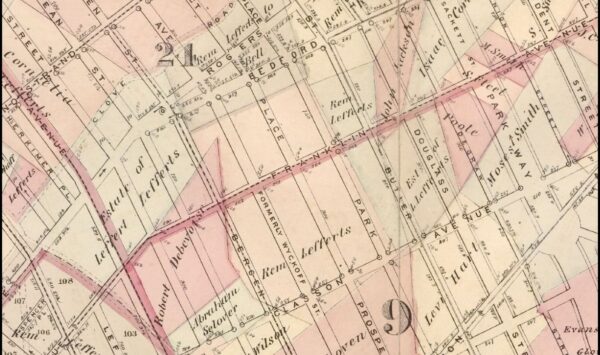
******************************************************************************************************************************** Brownstone Detectives investigates the history of our clients’ homes. The story you are about to read was composed from research conducted in the course of one of those investigations. Do you know the history of YOUR house? ******************************************************************************************************************************** Brooklyn was once one giant farm. At some point, as the farms began to be split up to be sold to developers – those who wanted to build rows of prized brownstones – companies also began to pop up which developed maps showing what types of buildings existed on every “lot” within the city. Although no longer used for fire insurance purposes, they are great tools for those owners wishing to research the histories of their properties. If you own a home in New York City, these maps can help you to determine how old it is, what else had been built in the area when your house was new, and, on some maps, the name of the farmer that had once owned your land. Find yours HERE. Follow @BrownstoneDetec Share ———————————————————————————————————————– The Brownstone Detectives Brownstone Detectives is an historic property research agency. Our mission is to document and save the histories of our clients’ homes. From our research, we produce our celebrated House History Books and House History Reports. Contact us today to begin discovering the history of your home.
THE MARXIST AT No. 477 E. 16th St. (1910)
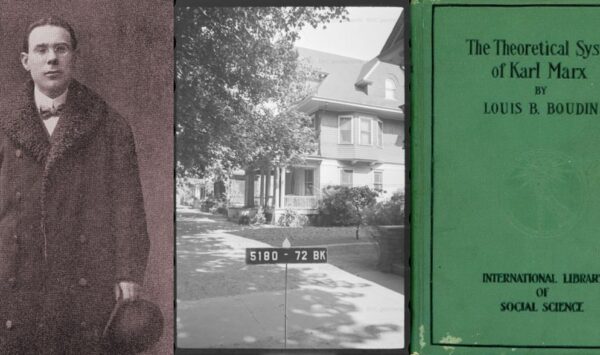
******************************************************************************************************************************** Brownstone Detectives investigates the history of our clients’ homes. The story you are about to read was composed from research conducted in the course of one of those investigations. Do you know the history of YOUR house? ******************************************************************************************************************************** At No. 477 East Sixteenth Street lived a Socialist. He wasn’t your ordinary, run-of-the-mill Socialist, however. Louis B. Boudin was a Russian-born American Marxist theoretician, writer, politician, and lawyer, who wrote a two volume history of the Supreme Court’s influence on American government as well as his piece de resistance, The Theoretical System of Karl Marx in the Light of Recent Criticism, first published in 1907. Boudin’s family emigrated to America in June 1891 and settled in New York City. He worked in the garment industry as a shirt maker and as a private tutor. At the same time, Boudin began legal studies, gaining a Master’s Degree from New York University and being admitted to the New York State Bar Association in 1898. At first, Boudin was a member of the Socialist Labor Party of America. He was also a member of the governing National Executive Board of the party’s trade union affiliate, the Socialist Trade and Labor Alliance from 1898 to 1899. Although he left the party for a short period, he returned after the turn of the century, being elected a delegate of the Socialist Party of America of the International Socialist Congress in Stuttgart in 1907 and the 1910 Copenhagen Congress of the Second International. Boudin was frequently […]
No. 4 EAST 78th ST, UES: A BRIEF HISTORY
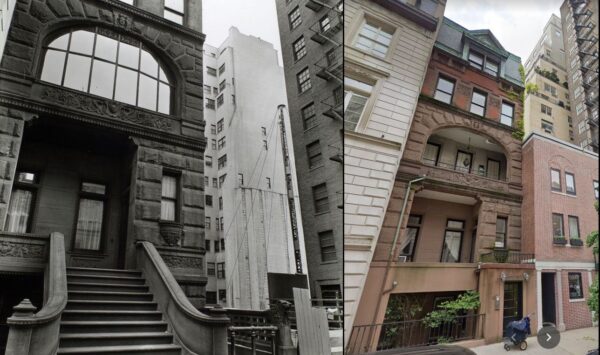
******************************************************************************************************************************** Brownstone Detectives investigates the history of our clients’ homes. The story you are about to read was composed from research conducted in the course of one of those investigations. Do you know the history of YOUR house? ******************************************************************************************************************************** According to Christopher Gray’s Streetscapes: Reader’s Questions, of the New York Times, No. 4 East 78th Street, is a Queen Anne-style house “built in 188 by the developer-architect Edward Kilpatrick. Upon completion, Kilpatrick sold it to the family of Arnold Falk, then living in a rowhouse at 129 East 64th. Mr. Falk was in the tobacco business on Water Street with his brother, Gustav, who lived in an adjacent house, 131 East 64th. On East 78th, Mr. Falk lived with his wife, Fannie, their two children and four servants. In the 1910’s and the 1920’s the house was occupied by the family of Jacob Dreicer, a principal in the Dreicer & Company jewelry firm founded in 1869, which was prominent in this period. There are now seven apartments in the building.” (New York Times, Sunday, 2 June 1991) Follow @BrownstoneDetec Share ———————————————————————————————————————– The Brownstone Detectives Brownstone Detectives is an historic property research agency. Our mission is to document and save the histories of our clients’ homes. From our research, we produce our celebrated House History Books and House History Reports. Contact us today to begin discovering the history of your home.
BODY-BUILDING IN THE GOWANUS (1911)
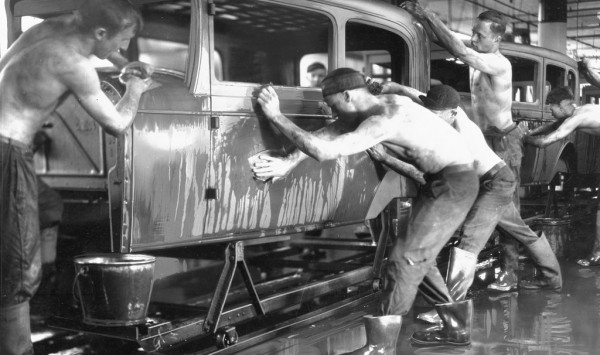
******************************************************************************************************************************** Brownstone Detectives investigates the history of our clients’ homes. The story you are about to read was composed from research conducted in the course of one of those investigations. Do you know the history of YOUR house? ******************************************************************************************************************************** Brooklyn’s Third Avenue was always just a bit gritty – even before the city decided it needed a motorway there to help ease congestion. That was when it started construction on the Gowanus Expressway in 1939. Traffic, though, had always been a large part of the avenue’s make-up. Even before the motorized vehicles, there were the horse-driven vehicles – cars, vans, streetcars, &c. But it was not just the vehicles that motored along the road that gave Third Avenue its rep – it was also those that parked alongside it – on lots, motor pools, parts yards, and other commercial properties. DONIGAN & NEILSON: BODY-BUILDERS One company that fit perfectly into its surroundings was Donigan & Neilson at 743-747 Third Avenue. This partnership’s firm catered to those commercial companies that operated using a variety of vehicles – to deliver, to haul, to move, &c. Donigan & Neilson built the bodies for those commercial vehicles – designing, building and assembling the bodies for hacks, trucks, vans, delivery wagons, and the like. This, of course, was before the assembly-line manufactured truck, when it made sense to have a commercial truck body made to order. According to their advertising, Donigan & Neilson began operations in 1875, when only horses propelled vehicles, and they were […]
FINDING YOUR BROWNSTONE – IN 1924
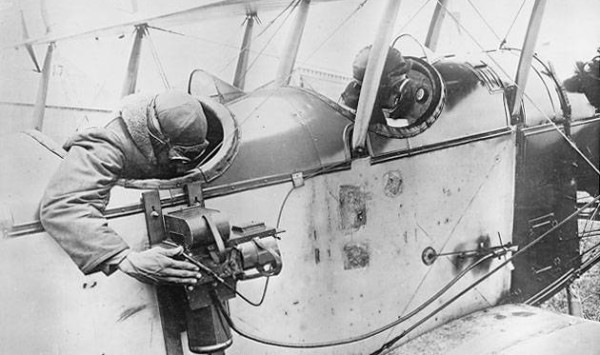
******************************************************************************************************************************** Brownstone Detectives investigates the history of our clients’ homes. The story you are about to read was composed from research conducted in the course of one of those investigations. Do you know the history of YOUR house? ******************************************************************************************************************************** Have you ever wondered what your neighborhood looked like in 1924? Or 1951? Or 1996? Aerial photography exists of all of New York City’s neighborhoods and is available to view (and zoom in on!) for free just by visiting NYC Map (a service of the City of New York). Simply type your address in the box at the top of the page and click “Search.” Then – in the upper right hand corner of the map – click on “Map Type,” and select the year you would like to view. Here is a view of Stuyvesant East in Bedford-Stuyvesant (showing Saratoga Park) in 1924. As you might have guessed, you won’t be able to see the expressions on peoples’ faces with this imagery, but it will give you a good indication of what your neighborhood looked like in any of these years. For comparison’s sake, here is a view of the same section of Bedford-Stuyvesant (as above) – but for 1996. What differences do you note between the two pictures? Comparing the two maps, you can see some obvious changes. Other than the fact that the second image is in color and was apparently taken in the winter time, if you look closely, you can see how whole swaths of brownstones […]